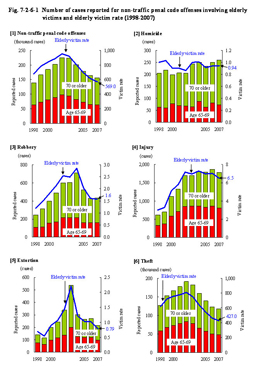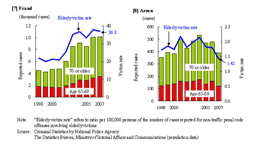| Previous Next Index Image Index Year Selection | |
|
|
1 Elderly victims and their ratio Fig. 7-2-6-1 Number of cases reported for non-traffic penal code offenses involving elderly victims and elderly victim rate (1998–2007) The number of cases reported for non-traffic penal code offenses involving elderly victims reached a peak in 2002 at 225,095, but has been decreasing in recent years. The elderly victim rate is also decreasing in a similar manner. This decreasing trend in the reported cases is in contrast to the increasing trends in both the number of elderly prosecuted for non-traffic penal code offenses and their ratio per 100,000 elderly (see Section 1 of this Chapter).Of 1,540,070 cases reported for non-traffic penal code offenses involving human victims (excluding cases in which the victims were corporations or other organizations and bodies, and those in which the victims' age was unknown) in 2007, elderly victims were involved in 156,271 (10.1%). Of cases involving elderly victims, 117,275 (75.0%) were for theft, 10,110 (6.5%) for fraud, and 1,784 (1.1%) for injury. On the other hand, the elderly victim rates in 2007 were 427.0 for theft, 36.8 for fraud, and 6.5 for injury. Changes in the number of cases reported for these offenses over the last 10 years reveal that theft cases have been decreasing after reaching a peak in 2002, and that fraud and injury cases are leveling off after a sharp increase. Furthermore, of cases reported for non-traffic penal code offenses involving human victims (excluding cases in which the victims were corporations or other organizations and bodies, and those in which the victims' age was unknown), the elderly rate was the highest for arson (35.1%), followed by homicide (21.7%), fraud (20.6%), and robbery (10.3%). |

